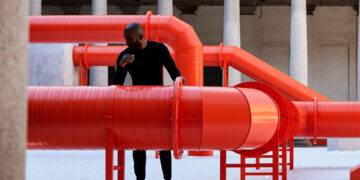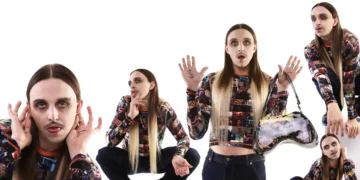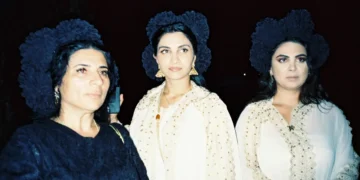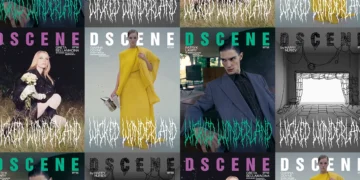
At Milan Design Week 2024, the unveiling of the Formation 02 smart toilet marked a significant milestone in the collaboration between Dr. Samuel Ross, his studio SR_A, and Kohler. Hosted at the historic Palazzo del Senato, the event featured a large-scale, site-specific installation titled Terminal 02, specifically designed to introduce this innovative product.
PRE-ORDER IN PRINT and DIGITAL
DSCENE magazine‘s editors Katarina Doric and Zarko Davinic caught up with Dr. Samuel Ross during the presentation to talk about the creative process behind the Terminal 02 installation and the design philosophy of the Formation 02 smart toilet. Moving beyond traditional design setup, Ross emphasized his commitment to exploring and disrupting the grey areas within household fixtures. By returning to manual artistic processes, he aims to inject a sense of personal craftsmanship into modern design, challenging the reliance on digital tools and reinvigorating the dialogue around the role of human creativity in shaping our living spaces.
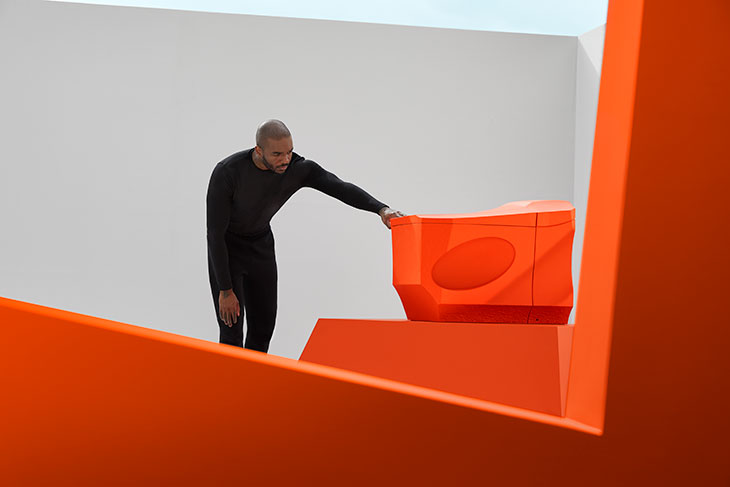
Dr. Ross, your collaboration with Kohler presents a bold approach to design that challenges traditional views. What was the inspiration? – It’s almost like there are these amazing categories that haven’t had disruption or a radical perspective placed for so long, and I really wanted to find the grey area or the white space to articulate newness. At this stage in my career, I understand the fundamentals, and now I’m driven to deconstruct them, to play and experiment. I’m also thinking about how our generation frames what we have to say within the lexicon or canon of design culture, which is why I’m making more provocative workshops. I’m finding more buoyancy in how I articulate through my work and aiming to make it increasingly relevant. Take the bathroom, for example—why haven’t we rethought this space?
At this stage in my career, I understand the fundamentals, and now I’m driven to deconstruct them, to play and experiment.
However, it’s challenging because it has already been done so many times. – Yes, but I started changing my design process when I started working with Kohler, while I was also preparing my Friedman Benda solo show in New York. I moved away from rendering software like Photoshop and Adobe, opting for painting and sketching with charcoal instead.

I love that you always show your design process. – It’s the cadences and quirks and errors that occur in the process of using the hand, which you can’t factor into the process, which help your signature and also break you out of becoming too linear. I’d say that was the way I approached this.
I thought, yes, there was a mood board and yes, there were questions I had tied to the magnitude and volume of water being delivered safely and the engagement of all of that process that is hidden. But it was also about not going on a computer and Photoshopping and not having it end point. There were questions, but they’re going into all of the sketching to unlock newness.
There’s something so human about sketches that people gravitate towards. Whether it’s the intimate, emotional sketches or the raw errors that occur during the drafting phase, they connect more than perfect digital renders.
How do you think the reliance on AI and digital tools has impacted the field of design? – This dependency can be damaging. Even before AI, we relied heavily on programs like Adobe or Rhino for rendering, but now, there’s a significant shift needed back towards manual processes. This is where the real cadences of design develop—often through error. For example, the predetermined views of what a toilet or tap should look like—I choose to go the complete opposite way and not reference those at all. Architects are trained to draw by hand, a skill that’s becoming sacred. Now, it’s rare for new designers to hand-draw, which is why I emphasize the importance of manual sketching in our processes.

It sounds like you’re advocating for a return to more traditional design methods? – Absolutely. There’s something so human about sketches that people gravitate towards. Whether it’s the intimate, emotional sketches or the raw errors that occur during the drafting phase, they connect more than perfect digital renders. Our internal team, which is humorously comprised mainly of architects and lawyers, follows every project from sketch to 3D modeling, to rendering, to technical drawing, and through every layer of fabrication. We maintain this comprehensive approach because we can speak the language of architecture and design fluently, ensuring that our projects are not only well-conceived but also meticulously executed.

